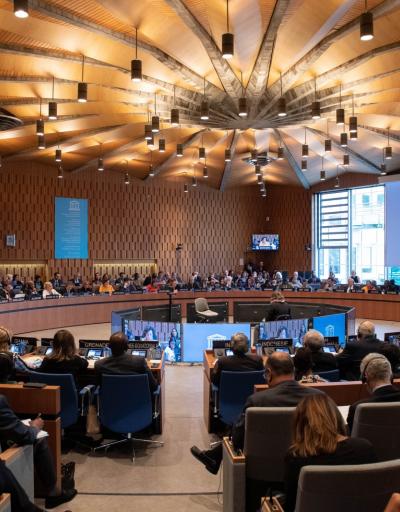
More information on 104 EX/Decision 3.3

The procedure followed by UNESCO in the examination of communications relating to cases and questions concerning the exercise of human rights in its spheres of competence is laid down in 104 EX/Decision 3.3. This procedure replaces that laid down in (77 EX/Decision 8.3).
Under this procedure, any communication received by the Director-General and appearing, at first sight, to be covered by the provisions of 104 EX/Decision 3.3 is treated in the following manner:
(a) it is given a serial number, by which it is referred to throughout the procedure;
(b) an action form is prepared for each communication;
(c) as soon as possible after receipt of the communication, the Director of the Office of International Standards and Leal Affairs sends a letter to its author informing him of the procedure laid down in 104 EX/Decision 3.3, drawing his attention to the conditions governing admissibility listed in paragraph 14(a) of that decision and asking him to fill in a form. At the end of this form the author is asked to sign a declaration agreeing to the examination of his communication in accordance with 104 EX/Decision 3.3;
(d) as soon as possible after receipt of an affirmative answer from the author of the communication, a letter is sent by the Director-General to the government concerned, with a copy of the communication, informing it that any reply it may wish to make will be brought to the notice of the Committee and that a representative of the government concerned may attend meetings of the Committee in order to provide additional information or answer questions asked by members of the Committee on either the admissibility or the merits of the communication.
After allowing a reasonable time (three months) for the government to reply – further examination of the communication, however, not being conditional upon the receipt of such a reply – the Secretariat transmits to the members of the Committee the texts of the communications that have been dealt with as described above, together with a summary of the facts and information concerning the replies given by the government.
In accordance with paragraph 14(c) of 104 EX/Decision 3.3, the Committee meets in private session to examine the communications transmitted to it by the Director-General. Its first task is to determine whether the conditions governing admissibility set out in paragraph 14(a) are met. If the information furnished by the author of the communication is not such that the Committee can reach a decision on this point, it may ask the representative of the government concerned to supply further details and invite him to answer questions asked by members of the Committee on the admissibility or merits of the communication; the Committee may also draw on any relevant information at the disposal of the Director-General. Furthermore, by virtue of Article 30 of the Rules of Procedure, it may request the permission of the Executive Board to invite observers of Member States, non-Member States, intergovernmental or non-governmental international organizations and other qualified persons to address it on matters within their competence.
If the Committee considers that it needs further information before it can rule as to the admissibility of a communication it can keep the communication on its agenda with a view to obtaining such information.
Having declared a communication admissible, the Committee pursues its examination as far as possible, with a view to finding an amicable way of dealing with the matter so as to advance the promotion of human rights.
In this connection, attention should be drawn to the fact that paragraph 7 of 104 EX/Decision 3.3 reads:
‘Considering that, in matters concerning human rights within its fields of competence, UNESCO, basing its efforts on moral considerations and its specific competence, should act in a spirit of international cooperation, conciliation and mutual understanding, and recalling that UNESCO should not play the role of an international judicial body, …’.
It is the Committee’s responsibility to decide whether the affair in question is an individual and specific ‘case’ concerning violation of human rights or a ‘question’ of ‘massive, systematic or flagrant violations of human rights which result either from a policy contrary to human rights applied de jure or de facto by a State or from an accumulation of individual cases forming a consistent pattern’ (104 EX/Decision 3.3, paragraph 10). It should be noted that ‘cases’ are normally examined by the Executive Board in private meetings, whereas ‘questions’ may be examined by the Executive Board and the General Conference in public meeting (104 EX/Decision 3.3, paragraphs 14-18).
Having concluded its work, the Committee adopts a confidential report containing ‘appropriate information arising from its examination of the communications which the Committee considers it useful to bring to the notice of the Executive Board. The reports shall also contain recommendations which the Committee may wish to make either generally or regarding the disposition of a communication under consideration’ (104 EX/Decision 3.3, paragraph 15).

